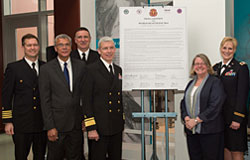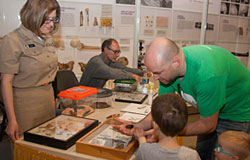Defense Department Demonstrates Historic, Ongoing Interest In Combatting Vector-Borne Diseases
April 28, 2014, Silver Spring, Md.: Senior leaders from several Fort Detrick and Fort Detrick-Forest Glen Annex agencies commemorated World Health Day 2014 on April 7, 2014, with a special proclamation signing ceremony at the National Museum of Health and Medicine (NMHM).
|
World Health Day 2014 spotlighted vector-borne diseases such as malaria and dengue. Malaria caused an estimated 660,000 deaths in 2010. Dengue is now the world's fastest-growing disease, with a 30-fold increase in incidence over the last 50 years. Diseases such as malaria, dengue, yellow fever, and others have a significant impact on America's armed forces and their families. Research to combat the sources of these infections is critical to maintaining readiness and the health and welfare of our service members. The leaders that gathered at NMHM on April 7 represented the DoD's major investment in research to protect service members affected by vector-borne diseases and to highlight ongoing efforts to develop new treatments, including a potential future vaccine for malaria. Speaking at the ceremony were Rear Admiral Bruce A. Doll, Director for Research and Development at the Defense Health Agency (DHA); Captain Keith A. Syring, MSC, USN, Deputy Commander, U.S. Army Medical Research and Materiel Command (USAMRMC); Captain John W. Sanders, MC, USN, Commanding Officer, Naval Medical Research Center (NMRC); Dr. Keith Carter, Senior Leader on Malaria, Regional Office of the World Health Organization (WHO); Colonel Shanda M. Zugner, Executive Officer, Walter Reed Army Institute of Research (WRAIR); Captain Gregory M. Beavers, MSC, USN, Director, Armed Forces Pest Management Board (AFPMB); and Dr. Adrianne Noe, Director, NMHM. Major General Joseph Caravalho, Jr., Commanding General, U.S. Army Medical Research and Materiel Command, offered greetings to the proclamation ceremony: "Infectious diseases have traditionally been the greatest threat to soldier health and readiness. That's what the U.S. Army Medical Research Institute of Infectious Diseases and WRAIR and our overseas labs are dedicated to rapidly detecting and protecting our soldiers from infectious diseases. For example, we've created and deployed rapid detection kits for West Nile and other viruses that soldiers can use anywhere, even on the battlefield. We continue to work on vaccines and treatments, including promising steps toward a malaria vaccine." "You ... have captured in 'small bite, big threat' a way to convey the message that, it may not be in our backyard all the time, but it is a worldwide threat and it deserves a worldwide effort to eradicate each of these significant threats that we face," said RADM Doll. "The proclamation signed today states that reducing vector-borne disease risk is in the interests of the American military and to the benefit of the American public," said AFPMB's CAPT Beavers. "I want to compliment all those people and organizations working here on the Forest Glen Annex to reduce those threats and human suffering around the globe. However, the job is not done and wall all need to keep pushing forward." |
 (standing l-r) Captain John W. Sanders, USN, Commanding Officer, Naval Medical Research Center; Dr. Keith Carter, Senior Leader on Malaria, Regional Office of the World Health Organization; Captain Keith A. Syring, USN, Deputy Commander, U.S. Army Medical Research and Materiel Command; Rear Admiral Bruce A. Doll, Director for Research and Development at the Defense Health Agency (DHA); Adrianne Noe, Director, National Museum of Health and Medicine (NMHM); Colonel Shanda M. Zugner, Executive Officer, Walter Reed Army Institute of Research; and Captain Mark Beavers, USN, Director, Armed Forces Pest Management Board are seen standing by a proclamation each has signed commemorating World Health Day 2014. The event took place on April 7, 2014 at NMHM in Silver Spring, Md. (Disclosure: This image has been cropped to emphasize the subject.) (National Museum of Health and Medicine photo / Released)  A museum visitor holds a Madagascar cockroach as LCDR Alexandra L. Singer, M.D., USN, Naval Medical Research Center (left), compares harmless insects to harmful insects (like mosquitoes and sandflies) during the World Health Day Family Program April 12, 2014 at the National Museum of Health and Medicine in Silver Spring, Md. World Health Day 2014 Family Program at NMHM. (Disclosure: This image has been cropped to emphasize the subject.) (National Museum of Health and Medicine Photo / Released) |
|
"Today's event ties our past and out present mission together incredibly well," said NMRC's CAPT Sanders. "We talk about the need to decrease anti-microbial resistance; stop and detect emerging and re-emerging pathogens; and to deal with these vector-borne diseases, not only for the benefit of our troops, but for the benefit of global public health ... it is a shared global health security mission." "We can't do this work alone," said WRAIR's COL Zugner, as she highlighted the agency's ongoing work on vector-borne diseases. "We've succeeded with development of a vaccine for Japanese encephalitis, and research continues on dengue and leishmaniasis, which we've seen even in the recent conflict in our service members." Noe described the unique role of the military's medical museum in furthering our understanding of disease transmission throughout the nineteenth and twentieth centuries, and in providing platforms to facilitate shared understanding today. NMHM and the other Forest Glen organizations also held a World Health Day Open House on April 12. Staff from AFPMB, NMRC and WRAIR showcased their research, as well as educated the public about insects, the importance of honey bees, and the latest advancements in insect repellents. A final World Health Day-related program took place on April 22, 2014, when LTC Norman Waters, Director of the Malaria Vaccine Branch at WRAIR, spoke at the NMHM Medical Museum Science Café in Silver Spring. Waters profiled the robust efforts by WRAIR and others to develop a malaria vaccine. |
|
Resources:



